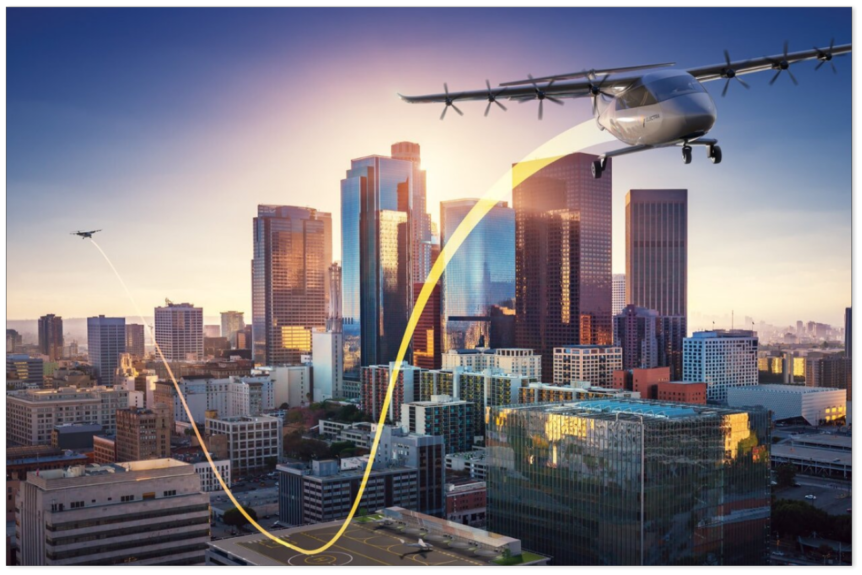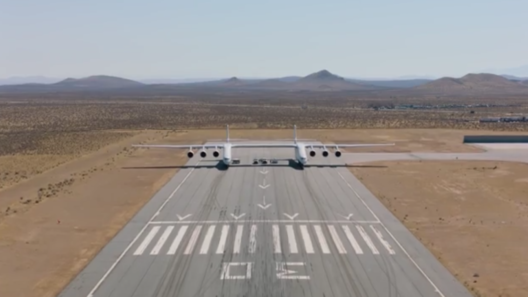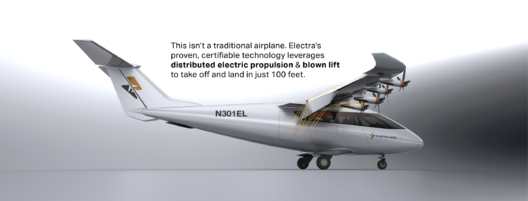Electra Aero has found worldwide interest in its electric ultra-short take-off and landing airplane, an eight-motor craft capable of taking off and landing across most jet-size runways.
Producing such an aircraft takes great design, appropriately-designed landing sites, a well-integrated infrastructure, and financial backing for the total package.
Electra Aero for the Design
Powered by a hybrid generator driving four electric motors, Electra Aero’s aircraft uses “blown lift” to take off over very short distances – less than 150 feet, according to the company.
Ben Marchionna, director of technology and innovation at Electra Aero, explains, “eVTOLs use electric propulsion to take off and land vertically – many of these concepts then transition from vertical flight to forward flight with a wing providing the lift once in cruise… Vertical flight requires significantly more power, resulting in an enormous payload, range, and cost penalty. eSTOLs use electric propulsion and an aerodynamic technique called blown lift to takeoff over distances as short as 100 feet. This provides eSTOL [electric Short Take Off and Landing] aircraft access to many of the same urban air mobility markets.”
He adds, “Blown lift uses the propellers to also blow significant amounts of air over large wing flaps that deflect the air downwards. This can be done very efficiently across the entire span of the wing with distributed electric propulsion systems. The technique has been used for nearly 75 years, with extensive research, flight testing, and operations by NASA and the USAF in the 1960s and 70s, but the advent of distributed electric propulsion now makes blown lift practical again.”
Marchionna worked with Dr. Alejandra Uranga, a Gabilan Assistant Professor at the University of Southern California’s Department of Aerospace and Mechanical Engineering to secure the contract.
Lockheed-Martin and Others for the Funding
In a Series A funding round, Electra received “an investment” from Lockheed Martin Ventures (LMV). The funding will support Electra’s plans to begin flight testing a full-scale hybrid eSTOL technology demonstrator aircraft later this year.
“’Hybrid-electric propulsion will influence every aspect of aviation,’ said John S. Langford, Founder and CEO of Electra. ‘We are excited to welcome Lockheed Martin Ventures as one of our strategic and key investors in our Series A funding round. Lockheed Martin is a leader in aerospace and defense, and we believe this relationship is a complementary one for Electra and Lockheed Martin. We’re honored to have them on our team.’”
Chris Moran, Vice President and General Manager of LMV, explained. “We invested in Electra because of its focus on hybrid-electric technology. Hybrid-electric aircraft have the potential to deliver operational and environmental advantages over other aircraft, including increased payload and range without gambling on battery improvements.”
Jo Borrás writing in Electrek, casts a vote in support of Lockheed-Martin. “The recent wave of eVTOL aircraft promises a flying car future that takes the shape of people flying around in big, autonomous drones. As cool and future-iffic as that all seems, it also seems pretty sketchy at times.
“The Electra sSTOL concept? That seems to be much closer to reality, and seems like it could be just as easily put into place with the right partners. If I was putting down my own money? I’d wager that Lockheed Martin knows the space better than anyone, and follow in their footsteps.”
Skyportz, Flapper, and Bristow for the Infrastructure
Great aircraft and bold innovations may mean nothing without a supporting infrastructure. The giant German airships of the 1930s were slated to dock atop the Empire State Building, for example, but that vision never bore fruit.
Skyportz CEO, Clem Newton-Brown, at the Air Taxi World Congress in London announced that the first Australian Skyportz infrastructure for air taxis will be built at the Australian Advanced Manufacturing Center of Excellence (AACME) in Moreton Bay, Brisbane, Australia in 2023. “Skyportz has been accumulating sites in Australia since 2018 and we now have over 400 property partners ready to build out a Skyportz network.”’
Noting the need for new standards and regulations from the Australian government, he explained the next steps. “For this reason we are focusing initially on existing aviation infrastructure and places where it is possible to get a permit for a helipad which can transition into a future Skyportz. The AACME site was already proposing a helipad so this partnership has enabled us to bring forward our plans.” He explained this was a first step in, “Assembling the pieces of a future air taxi network.”
Flapper, a Brazil-based aerial charter service, has plans for linking its domestic and international flights with speedy transit between urban areas and larger airports. Where one of the tenets used to promote Urban Air Mobility is the democratization of flight, Flapper seems to appeal to wealthy South Americans who can hop off their local flight on a Flapper Electra to hop on to their much larger business jet. Sao Paolo to Buenos Aires is a $550 fare on regional airlines, but $2,500 on a Flapper charter craft such as a Gulfstream, for instance.
Bristow Group Inc., in business for over 70 years as a purveyor of rotary wing transport, will add its, “transport expertise to Electra’s development of the eSTOL aircraft’s operations, design, and safety features to meet customer as well as FAA, EASA (European Aviation Safety Agency) and Transport Canada certification requirements.” The first minute and 53 seconds details Electra’s work with Bristow, but as always, the rest of the Aero-News video is enlightening.
Electra may deliver as many as 50 aircraft to provide services for “middle-mile logistics for large retail distribution chains and other specialized customers.” Bristow and Electra have signed a Memorandum of Understanding (MOU) to cooperate on technical development and certification, followed by marketing and future operations of the hybrid-electric craft. The Electras would join the existing 240 aircraft Bristow fleet and augment the company’s annual revenues of over $1.2 billion.
Additional Funding
Electra.aero received a $1.5 million small business innovation research (SBIR) contract with a 15-month performance period, from the Air Force’s Agility Prime program in June.
Electra also received a $125,000 small business technology transfer (STTR) contract from NASA to mature its electric ultra-short takeoff and landing (eSTOL) aircraft, the company announced in a July 27 press release.
Growing interest and investments in these mid-range regional haulers will only increase as their presence in skies all over the world becomes more pronounced. Electra seems to have picked a good market in which to grow.




